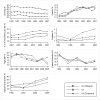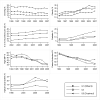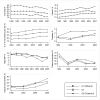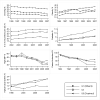Persistent socioeconomic inequalities in cardiovascular risk factors in England over 1994-2008: a time-trend analysis of repeated cross-sectional data
- PMID: 22333887
- PMCID: PMC3342910
- DOI: 10.1186/1471-2458-12-129
Persistent socioeconomic inequalities in cardiovascular risk factors in England over 1994-2008: a time-trend analysis of repeated cross-sectional data
Abstract
Background: Our aims were to determine the pace of change in cardiovascular risk factors by age, gender and socioeconomic groups from 1994 to 2008, and quantify the magnitude, direction and change in absolute and relative inequalities.
Methods: Time trend analysis was used to measure change in absolute and relative inequalities in risk factors by gender and age (16-54, ≥ 55 years), using repeated cross-sectional data from the Health Survey for England 1994-2008. Seven risk factors were examined: smoking, obesity, diabetes, high blood pressure, raised cholesterol, consumption of five or more daily portions of fruit and vegetables, and physical activity. Socioeconomic group was measured using the Index of Multiple Deprivation 2007.
Results: Between 1994 and 2008, the prevalence of smoking, high blood pressure and raised cholesterol decreased in most deprivation quintiles. However, obesity and diabetes increased. Increasing absolute inequalities were found in obesity in older men and women (p = 0.044 and p = 0.027 respectively), diabetes in young men and older women (p = 0.036 and p = 0.019 respectively), and physical activity in older women (p = 0.025). Relative inequality increased in high blood pressure in young women (p = 0.005). The prevalence of raised cholesterol showed widening absolute and relative inverse gradients from 1998 onwards in older men (p = 0.004 and p ≤ 0.001 respectively) and women (p ≤ 0.001 and p ≤ 0.001).
Conclusions: Favourable trends in smoking, blood pressure and cholesterol are consistent with falling coronary heart disease death rates. However, adverse trends in obesity and diabetes are likely to counteract some of these gains. Furthermore, little progress over the last 15 years has been made towards reducing inequalities. Implementation of known effective population based approaches in combination with interventions targeted at individuals/subgroups with poorer cardiovascular risk profiles are therefore recommended to reduce social inequalities.
Figures




Similar articles
-
Trends and Regional Variation in Prevalence of Cardiovascular Risk Factors and Association With Socioeconomic Status in Canada, 2005-2016.JAMA Netw Open. 2021 Aug 2;4(8):e2121443. doi: 10.1001/jamanetworkopen.2021.21443. JAMA Netw Open. 2021. PMID: 34410395 Free PMC article.
-
Trends in socioeconomic inequalities in five major risk factors for cardiovascular disease in the Korean population: a cross-sectional study using data from the Korea National Health and Nutrition Examination Survey, 2001-2014.BMJ Open. 2017 May 17;7(5):e014070. doi: 10.1136/bmjopen-2016-014070. BMJ Open. 2017. PMID: 28515188 Free PMC article.
-
Cardiovascular risk factors-using repeated cross-sectional surveys to assess time trends in socioeconomic inequalities in neighbouring countries.BMJ Open. 2017 Apr 3;7(4):e013442. doi: 10.1136/bmjopen-2016-013442. BMJ Open. 2017. PMID: 28373251 Free PMC article.
-
The contribution of health behaviors to socioeconomic inequalities in health: A systematic review.Prev Med. 2018 Aug;113:15-31. doi: 10.1016/j.ypmed.2018.05.003. Epub 2018 May 9. Prev Med. 2018. PMID: 29752959
-
Are inequalities in cancer diagnosis through emergency presentation narrowing, widening or remaining unchanged? Longitudinal analysis of English population-based data 2006-2013.J Epidemiol Community Health. 2019 Jan;73(1):3-10. doi: 10.1136/jech-2017-210371. Epub 2018 Nov 8. J Epidemiol Community Health. 2019. PMID: 30409920 Free PMC article. Review.
Cited by
-
Global epidemiology, health burden and effective interventions for elevated blood pressure and hypertension.Nat Rev Cardiol. 2021 Nov;18(11):785-802. doi: 10.1038/s41569-021-00559-8. Epub 2021 May 28. Nat Rev Cardiol. 2021. PMID: 34050340 Free PMC article. Review.
-
Trends in socioeconomic inequalities in ischemic heart disease mortality in small areas of nine Spanish cities from 1996 to 2007 using smoothed ANOVA.J Urban Health. 2014 Feb;91(1):46-61. doi: 10.1007/s11524-013-9799-6. J Urban Health. 2014. PMID: 23564269 Free PMC article.
-
Decomposition of gendered income-related inequalities in multiple biological cardiovascular risk factors in a middle-aged population.Int J Equity Health. 2018 Jul 13;17(1):102. doi: 10.1186/s12939-018-0804-2. Int J Equity Health. 2018. PMID: 30005665 Free PMC article.
-
Self-reported health and socio-economic inequalities in England, 1996-2009: Repeated national cross-sectional study.Soc Sci Med. 2015 Jul;136-137:135-46. doi: 10.1016/j.socscimed.2015.05.026. Epub 2015 May 18. Soc Sci Med. 2015. PMID: 26004207 Free PMC article.
-
Trends in risk factors for coronary heart disease in the Netherlands.BMC Public Health. 2016 Aug 19;16(1):835. doi: 10.1186/s12889-016-3526-7. BMC Public Health. 2016. PMID: 27543113 Free PMC article.
References
-
- Capewell S, Beaglehole R, Seddon M, McMurray JJ. Explanation for the decline in coronary heart disease mortality rates in Auckland, New Zealand, between 1982 and 1993. Circulation. 2000;102:1511–1516. - PubMed
-
- Hunink MGM, Goldman L, Tosteson ANA, Mittleman MA, Goldman PA, Williams LW, Tsevat J, Weinstein MC. The recent decline in mortality from coronary heart disease, 1980-1990. The effect of secular trends in risk factors and treatments. JAMA. 1997;277:535–542. doi: 10.1001/jama.1997.03540310033031. - DOI - PubMed
-
- Kaplan GA, Keil JE. Socioeconomic factors and cardiovascular disease: a review of the literature. Circulation. 1993;88:1973–1988. - PubMed
Publication types
MeSH terms
Grants and funding
LinkOut - more resources
Full Text Sources

